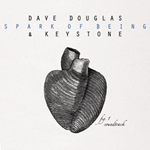|
|
 |
Dusted Reviews
Artist: Dave Douglas & Keystone Album: Spark of Being Label: Greenleaf Review date: Nov. 17, 2010 |

|
|
|
 |
Trumpeter and composer Douglas’ investigations of genre-bending improvised music have rarely been less than impressive, which is saying something over the course of a couple decades. Unlike certain musicians with mere aspirations to the status of conceptualist, Douglas is actually smart and he’s got taste enough (as player, composer, and bandleader) not to let it get in the way. This fall has seen the release of a three-part documentation of his multimedia collaboration with filmmaker Bill Morrison (originally presented at Stanford earlier this year). This first disc is the actual soundtrack.
His band here is Keystone, including tenor saxophonist Marcus Strickland, Rhodes ace Adam Benjamin, bassist Brad Jones (here on an Ampeg Baby Bass for tonal intensity and range), drummer Gene Lake, and DJ Olive on turntables and laptop (Douglas himself is also credited with the latter). It’s the kind of personnel that can bring together not only a bunch of Douglas’ compositional interest, but also – through shifting textures and elusive themes – can problematize both image and note. Indeed, from the opening minutes there are tons of fuzzy, grainy noise textures that recall Fennesz or Hecker, i.e. the softer end of the electronic spectrum. These are generally set within or alongside a group sound inspired by late 1960s Miles Davis groups, early 1970s Keith Jarrett (or even Old and New Dreams to some extent), and a consistent use of Harmon mute to pair with Strickland’s assured work, creating in my ears an impression of Douglas’ 1990s Booker Little tribute disc. Only occasionally do the electronics – gentle samples of crowd noise, a dollop of din, an occasionally recognizable scratching from Olive – disturb the proceedings. But they do create a fine atmosphere, somewhere between somnambulant and paranoid.
The tunes aren’t as memorable as some of Douglas’ other work, but the soundtrack setting wouldn’t (shouldn’t?) suggest otherwise; and at any rate, the other two discs in this series apparently compensate for this. But the instrumentalism is aces. You know going in that Douglas and Strickland are going to sound superb together (it’s especially effective when they create chorale effects amidst electronics, as on “Observer”), but it’s very nice that the saxophonist is starting to achieve attention comparable to his talents. He sounds particularly urgent and impassioned on the slightly mischievous “Creature and Friend,” which has some faint Hermeto overtones. But I was compelled by Benjamin’s Rhodes throughout, as he reminds of how effective an instrument it can be when the player thinks in terms of not just timbre but touch.
The music is at its best, though, when Lake and the bassists generate controlled momentum, stitching together complex and quite different rhythms without compromising spontaneity or propulsion. While I’m not sold on the odd IDM-ish indulgence on “Travelogue,” they’re terrific on the squiggly funk of “Chroma” or the urgent, angular “Tree Ring Circus” (and a high point is Lake’s total synergy with Olive’s turntables on “Observer”).
You’d think all these impressive moments would constitute a good album, but there’s something about this fuzz symphony that doesn’t linger. It’s true that, even shorn of context, this is evocative, scene-setting music; and as always, Douglas’ melodic invention and ear for the well wrought detail are compelling. But something about the whole doesn’t click.
By Jason Bivins
|







